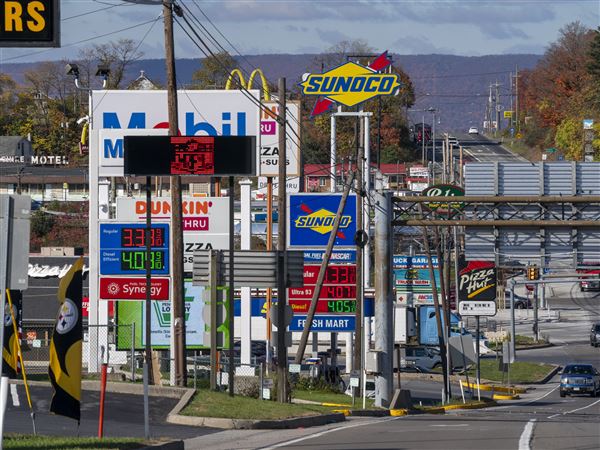A map above a light switch in Etna council chambers shows how much more vulnerable the river borough would be without teamwork.
Sanitary sewer connections with Shaler, O'Hara and Indiana townships are notated on the map surrounding Etna, whose population is 3,900. A main trunk line runs from the Etna-Shaler border along Pine Creek to the Allegheny River.
Pine Creek flooding has beset Etna through history, but Etna historically bore the cost of repairs when pipes couldn't handle water from upstream towns.
In 2004, rain from Hurricane Ivan took 10 minutes to reach the light switch in Etna's council chambers. Upstream in Shaler, flooding forced hundreds to seek shelter.
"That really opened people's eyes," said Etna borough manager Mary Ellen Ramage.
Ivan inspired a four-municipality collaboration that set the stage for a regional eye-opening four years later -- the 2008 consent decree requiring Alcosan and its 83 municipalities to comply with the federal Clean Water Act. The Pine Creek portion of the $2 billion-to-$3.6 billion compliance cost is $11 million. That cost wouldn't be Etna's to bear, but it is three times Etna's 2014 budget.
The big picture "is almost unaffordable to almost everybody," Ms. Ramage said. But costs are less painful when they're shared.
"Shaler, Indiana, Ross and Etna have an agreement to share maintenance of the main trunk lines, and each has an agreement with the other" on shared connections, she said. "They've been excellent at kicking in.
"People say, 'You're in a flood plain, you should tear these houses down,' but houses torn down affects the school and county tax base. Pittsburgh's rise as a region was built on places like Etna. You can't disregard them."
Etna's location in a flood plain notwithstanding, "upstream development has to be responsible," said Tim Rogers, Shaler's township manager. "The problem with flooding in Millvale is Girty's Run being unable to carry the flow from Mc-Knight Road."
Ms. Ramage said Etna cleans its sewers regularly but doesn't have a vacuum truck. Shaler answers Etna's call with its vacuum truck. Shaler's median income is $62,000 while Etna's is $32,000. Shaler has nine times Etna's population.
"We have a flood retention facility that's of no benefit to Shaler but to Etna," said Mr. Rogers, explaining: "Our relatives and friends live in Etna and we're part of the same school district."
Collaboration lies at the heart of a steering committee's call for regional cost sharing to address Alcosan's overflow violations. It also recommends that Alcosan take over municipal trunk mains.
Ms. Ramage, who is on the committee, said the consent decree shows the problem and solution reside with everybody.
"When you're on the highway," she said, "you don't know you've gone through four towns. Neither does rain water."
The consent decree required Etna to install cameras at junctures in its storm lines so that the borough can monitor them and prevent clogs, she said.
"When we went in to do that, we found lines that were right angle after right angle, which diminishes flow. We wondered, 'Why would anyone do that?'
"Pine Creek had to be diverted for Route 28 in 1958, and when we went in to camera that pipe, we found it wasn't flush" at the joint. "It was probably the cheap way out, but in 50 years, how much dirt do you think was getting in there and how much sewage was getting out?"
Etna has not only joined hands with neighbors to strengthen the ties that bind them but has initiated projects to keep rain out of its municipal lines. In the spring, an Environmental Protection Agency grant will help Etna disconnect downspouts in one block of the Butler Street business district. A decorative grate over a gulley in the sidewalk will carry rain to a rain garden. Parking lot owners will be offered incentives to replace pavement with permeable surfaces.
The borough already has disconnected roof leaders from its swimming pool recreation house and installed rain barrels.
"People ask, 'How much difference can that make?' " Ms. Ramage said. "But if you think that way, we'll never solve this problem."
Shaler is retaining stormwater, too, starting with a bioswale at the municipal building that collects roof water, and has planning requirements for rain retention with new development.
While reductions continue, rates will go up. The water and sewer fee in Etna of $7.60 per 1,000 gallons will increase by 11 percent.
"We have to be careful it isn't too much for people to bear," Ms. Ramage said. "The solution is to spread out all the costs" toward compliance. "We are all interconnected."
First Published: December 29, 2013, 5:02 a.m.
















